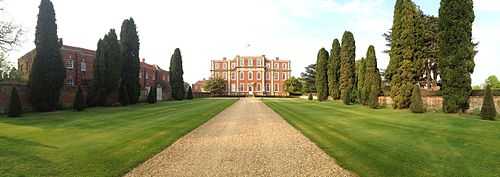Chicheley Hall

Chicheley Hall, in Chicheley, Buckinghamshire, was built in the first quarter of the 18th century in the Baroque style. It is one of the finest country houses in Buckinghamshire, described by Marcus Binney in The Times as "one of the dozen finest and loveliest English country houses that will ever come on the market".[1]
Earlier buildings
An ancient manor house on the site belonged to the Pagnell family of Newport Pagnell, but was given by them to the church. Cardinal Wolsey gave it to Christ Church, Oxford, but it reverted to the Crown, and was acquired by a merchant, Anthony Cave in 1545, who built a manor house in the form of a hollow square.[2] By the time of the English Civil War, the house belonged to the Chester family. The house was damaged during the war, and demolished afterwards. The present Chicheley Hall was built on the same site. All that remains of the old manor today is one Jacobean over-mantel with termini caryatids, and some panelling in the 'new' Chicheley Hall.
Current hall
The present hall was built between 1719 and 1723, with the interior fittings completed in 1725.[3] The house was often attributed to the architect Thomas Archer, but has more recently been attributed to Francis Smith, who is thought to have designed it for Sir John Chester.[1]
The principal facade of the house is of nine bays on three floors upon a raised basement; the central section of three bays projects. Massive fluted Corinthian pilasters flank the central three bays. These are repeated at each termination of the facade and again divide the second from the third bay of each wing that flanks the central projection. The facade is symmetrical, however the curve-topped windows of the central projection are taller than the flat-topped windows of the wings, thus uniformity at roof level is achieved by an upward curve to the central section from the wings. These motifs, examples of baroque architecture are exceedingly rare in Britain, where baroque was fashionable for a very brief period at the end of the 17th century and beginning of the 18th.
The main door opens to a fine panelled Great Hall, in the manner of William Kent with a classical double-height ceiling depicting Herse and her sisters sacrificing to Flora. Through an arcade of marble columns, oak staircases lead to the upper floors. The most remarkable room is the 'secret' library on the upper floor, with all shelving and books concealed behind what appears to be panelling, thus disguising the room's true use. The interior includes some of the finest woodcarving, joinery and plasterwork in any English country house of its period.
The house is surrounded by a park of 100 acres (0.40 km2), including a lake, canal, and 25 acres (100,000 m2) of gardens, laid out by George London and Henry Wise. An avenue of lime trees leads to the house, past an octagonal dovecote. The River Ouse lies to the east.
Recent history
During the Second World War, Chicheley Hall was used by the Special Operations Executive as its Special Training School No. 46. From 1942 until 1943, it was used for training Czechoslovaks for SOE parachute missions.[4][5] It was later used to train Polish agents, and then became a FANY wireless telegraphy school.[6] Fortunately, the fine interior was protected by hardboard.
The house was purchased from the Chester family by David Beatty, 2nd Earl Beatty in 1952, son of First World War Admiral Lord Beatty, who brought memorabilia of his father. Beatty began a large restoration program and finally employed the renowned interior decorator Felix Harboard, famed for his work at Luttrellstown Castle near Dublin. Harboard's masterful, classical colour schemes accentuating moulding and panelling perfectly suit the house.
Chicheley Hall remained the home of the 2nd Earl's fourth wife, Diane, after his death. She remarried, to Sir John Nutting, and was later the chairman of the Georgian Group. Together, they ran the house as a venue for weddings and conferences. The house stood in for Bletchley Park in the 2001 film Enigma. It has also been used as a location in several other films and TV projects, including Pride and Prejudice, The Meaning of Life, The Red Violin, Black Beauty, The Fourth Protocol, A Village Affair (1995 TV Movie), Separate Lies.
In 2007, Grade I listed Chicheley Hall was placed on the market for sale, with a guide price of £9 million.[7] It was bought by the Royal Society for £6.5 million, funded in part by Fred Kavli. The Royal Society has spent a further £12 million renovating the house, and adapting it to become the Kavli Royal Society International Centre, a venue for science seminars and conferences. Outside of these scientific events the Hall may be used by others for corporate and social events.[8]
References
- ↑ 1.0 1.1 "The finest country house on the market", Times Online, June 8, 2007
- ↑ SOE Chichley Hall
- ↑ http://web.archive.org/web/20080617094658/http://www.chicheleyhall.co.uk/about.html ; although Pevsner gives the date of construction as 1698 to 1703.
- ↑ "Czechs in Exile – Addington House". The Czechoslovak Government in Exile Research Society. Retrieved 31 January 2011.
- ↑ Rees, Neil (2005). The Secret History of The Czech Connection – The Czechoslovak Government in Exile in London and Buckinghamshire. ISBN 0-9550883-0-5.
- ↑ S.O.E – Training of the S.O.E
- ↑ Chicheley Hall | News | Houses for sale, properties for sale – Country Life
- ↑ "Royal Society snaps up a stately hothouse", Times Online, March 29, 2009
- Pevsner, Nikolaus (1973). Buckinghamshire. England: Penguin Books Ltd. ISBN 0-14-071019-1.
External links
- http://www.chicheleyhall.co.uk – The Kavli Royal Society International Centre at Chicheley Hall
Coordinates: 52°06′13″N 0°40′45″W / 52.1036°N 0.6792°W
- http://royalsociety.org/ – The Royal Society